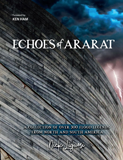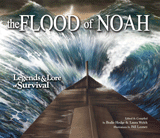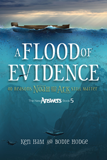
Flood Legends from the Americas, Part 2: Canada and the Arctic
Introduction
The earliest explorers of Canada and the Arctic regions of North America found the knowledge of the flood among all the tribes they met, in remarkable correspondence with the Genesis account. We possess over 36 aboriginal traditions of the flood from this area alone! There are several accounts of creation, the fall, and the tower of Babel as well.
Make no mistake: these traditions do not speak of a local flood, or some generic flood story. They match the Noahic flood account on several specific details. There can be no doubt that they are referring to the flood of Noah, described in Genesis.
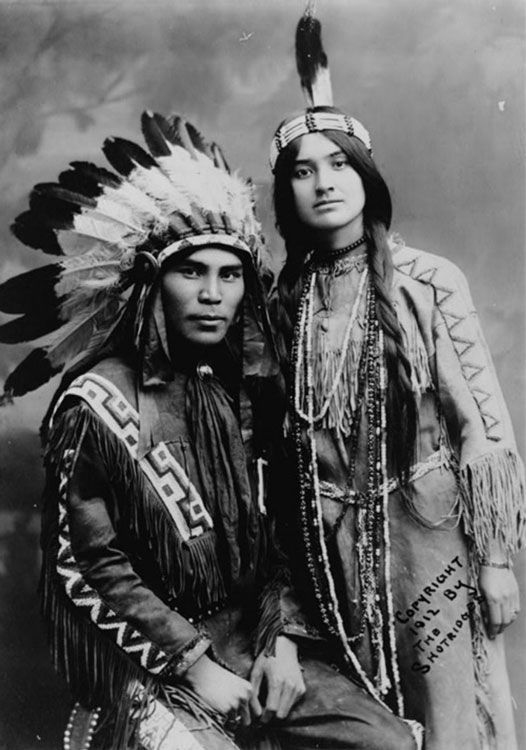
Tlingit Couple (Situwuka and Katkwachsnea), by Louis Shotridge, 1912
“Amongst one hundred and twenty different tribes that I have visited in North and South and Central America, not a tribe exists that has not related to me distinct or vague traditions of such a calamity, in which one, or three, or eight persons were saved above the waters, on the top of a high mountain.” (George Catlin, early 19th century explorer and painter)
This expansive array of flood traditions, documented in my book Echoes of Ararat, is exactly what we would expect to find if the biblical account is true. This unequivocal body of evidence demands an explanation. It will be found that the only explanation that will do it justice is the truth of the Genesis record—in light of the sheer volume of these tribal traditions, their antiquity, and the specific details with which they match the Genesis account.
Eastern and Central Canada Flood Legends
“Now all the writers of barbarian histories make mention of this flood and of this ark.” (Josephus, ca. A.D. 90)
Let us begin with the Cree people, that settled a vast section of Canada. Their ancient tradition, passed down from generation to generation, states that God sent the flood because people became completely disobedient. But a good man named Wesaketchan “built a large raft on which he boarded all his family, as well as a pair of all the birds and all the animals.” The man sent out a raven and a dove, the latter of which “returned with a piece of clay in its legs. The man concluded that the earth was quite dry, and he landed.”1 The Montagnais or Innu of eastern Canada said, “God, being angry with the giants, commanded a man to build a large canoe. The man did so, and when he had embarked in it, the water rose on all sides, and the canoe with it, till no land was anywhere to be seen.” They have a memory of Noah’s raven too.2
Being warned of the Flood in a dream, their ancestor built a raft to save his family and all types of animals, floating upon the waters for many moons (Ottawa tradition told to Alexander Henry)
The Ojibwe people of Canada and the Great Lakes area, tell that their patriarch built a giant raft and rescued all sorts of animals and birds upon it. “On this raft he floated about for a long time, till all the mountains were covered, and all the beasts of the earth and fowls of the air, except those he had with him, perished.”3 The Ottawa, around the year 1770, told the fur trader Alexander Henry about their ancestor Nanibojou, their Noah, who “lived originally toward the going down of the sun, where being warned, in a dream, that the inhabitants would be drowned by a general flood, produced by heavy rains, he built a raft, on which he afterward preserved his own family, and all the animal world without exception. According to his dream, the rains fell, and a flood ensued. His raft drifted for many moons, during which no land was discovered.”4
Western Canada Flood Legends
Flood Legends from the Americas
- Part 1: Continental United States
- Part 2: Canada and the Arctic
- Part 3: Mexico to South America
In western Canada, we find a multitude of peoples with traditions that testify to the truth of the Genesis record. Among these, the Lillooet people, in 1905, told anthropologist James Teit their sacred tradition. A man named Ntci’nemkin “had a very large canoe, in which he took refuge with his family.” The floodwaters rose “until all the land was submerged except the peak of the high mountain called Split. The canoe drifted about until the waters receded, and it grounded on Smimelc Mountain.” When the waters went down, the survivors came out and repopulated the earth.5
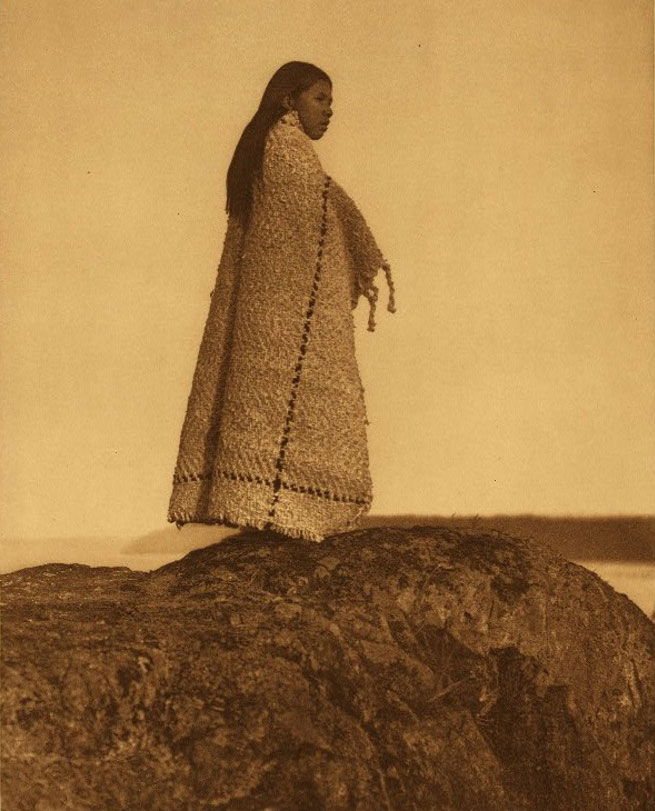
Cowitchan Girl, by Edward S. Curtis (1913)
The Nootka told that a good and discerning man, Wispohahp, foresaw the flood and made preparations with his brothers. “In his canoe were placed all his movables, his wife, his two brothers, and their wives. . . . Finally, the water covered the whole country, except Quossakt, a high mountain near the Toquahts, and Mount Arrowsmith.” When the earth had dried, they came out and repopulated the earth.6
‘Finally the rain stopped, and they felt the waters going down, and their raft rested on the top of Cowichan Mountain’
In 1888, the Sarci elders related how, in ancient times, “when the world was flooded there were only one man and one woman left, and these two saved themselves on a raft, on which they also collected animals and birds of all sorts.”7 The Squamish people too had their tradition of the global flood which, while it was slowly advancing, a Great Council met and decided that “a giant canoe should be built” and that all the children should be placed in this canoe, with one young man and woman to guide the ship. Then, “all was a world of water,” and “for days and days there was no land." Finally, the Flood receded and the boat came to rest again on Mount Baker. The surviving young people went down from the mountain and repopulated the earth.8
“We have a tradition about the swelling of the water a long time ago,” told a Tsimshian chief to one Mr. Duncan, in which “all people perished in the water but a few.”9 The Bella Coola said that “the surface of the waters covered all the land up to the peaks of the mountains.” They also have a vague tradition of the confusion of languages, which they said took place after the flood.10

See the book Echoes of Ararat for more information on this subject.
The Cowichan tribal elders told that, long ago, certain people started having terrifying dreams. “One man said, ‘I have dreamed a strange thing,’ and the others were eager to hear what he had to say. ‘I dreamed that such rain fell that we all were drowned.’ ‘I,’ said another, ‘dreamed that the river rose and flooded the place, and we were all destroyed.’ ‘So did I,’ chimed in another. ‘And I too.’ They determined to build a “huge raft of canoes tied together.” Others jeered and mocked, who did not believe in these dreams. But those who believed “took their families and placed them on the raft and took food and waited.” Then the flood came, and “the raft rose with the water, and was the only thing seen for many days.” Those who formerly mocked fled to the mountains, but those soon were under the water too. Finally, those on the giant raft “felt the waters going down, and their raft rested on the top of Cowichan Mountain.”11
“At one time there was a flood that covered the earth … All the land was flooded except the tops of a few very high mountains. Xals and his wife and daughters escaped in a large canoe. … They drifted against the top of Qotselis Mountain … The water at last receded, and they cast off their canoe.” (Coastal Salish tradition told to James Teit, ca. 1916)
“All the land was flooded,” said the Coastal Salish, “except the tops of a few very high mountains. Xals and his wife and daughters escaped in a large canoe. … They drifted against the top of Qotselis Mountain … the water at last receded, and they cast off their canoe.”12 The Carrier people told that a boy survived the flood on a raft, and sent a wolf (instead of Noah’s dove) to see whether the newly appeared land was ready for habitation.13 The Tahltan related that a wise man was forewarned of the coming flood, sent by God due to the wickedness of mankind. Their tradition also mentions a race of fallen beings that existed in those days, and a confusion of languages that occurred after the flood.14 The Tsetsaut said their ancestors “resolved to enclose their children in hollow trees,” and that “they gave them an ample supply of food, and then closed up the trees with wooden covers, which they caulked with pitch.” After the flood ended, they came out and then repopulated the earth.15 And we have the flood traditions of other communities besides, including the Shuswap, Kootenay, Kwakiutl, Haida, and Beaver peoples.
“Mankind and the animals all did as they pleased, quarreled and shed much blood,” said the Western Cree. “The quarrels of men and the animals made the ground red with blood,” and “this made the Great Spirit very angry.” Therefore, the Great Spirit sent the flood. One man survived, and a few animals with him, one of which was sent and returned with a piece of earth. The Western Cree also recognize the rainbow as “the mark of life,” the sign that the Great Spirit will not again destroy the earth with a flood.16
The earliest explorers of Canada and the Arctic regions found the knowledge of the Flood among all the tribes they met, in remarkable correspondence with the Genesis account
The Saulteaux people, around the year 1850, told Lieutenant Hooper “of a medicine-man named Wis who built a big canoe in which he put all classes of animals. A great deluge occurred and covered all land, hills, and trees.” After the flood, “he sent out a crow and, when it did not return, he concluded it [the earth] was now large enough for all to inhabit. So he and all the animals got out from the boat.”17
The Arctic Region Flood Legends
“Some of these tribes [of Alaska] have not only tradition of the Noachic Deluge, but also of the original Chaos, the first dividing of the waters, and the creation of heavenly bodies, plants, animals and men in nearly the Mosaic order of succession. And these traditions have evidently no touch of “white men’s teaching.” (Julia McNair Wright, ca. 1885)
In the far northern regions of this continent, we find the Dene people group, who inhabit much of Alaska and the northwestern parts Canada. According to their tradition, an old man named Tchapewi “made a large raft, on which he placed a couple of each kind of animal, and he drifted away on his raft.” The flood covered the entire earth for a long time, including the highest mountains of the Rockies. The Dene also preserved the memory of the crow, which the old man set loose, followed by the dove. “Having been sent a third time, it [the dove] returned in the evening, tired out, and holding in its foot a green branch of fir.”18 The Yupiks of Alaska tell of a great flood, which only a few people survived in their fur boats, and then landed on the highest mountains.19 The Kaigani, an Alaskan tribe, referred to “the big canoe in which a good man was saved in the time of a great flood.” This landed on a high mountain. He later sent a crow to see if the waters had gone down.20
The old men of the Dogrib people, living in the Northwest Territories, told that in the earliest times, a god-like man named Chapewee “created children, to whom he gave two kinds of fruit, the black and the white, but forbade them to eat the black.” They obeyed him for a while, but when he left on a long excursion, “they forgot the orders of their father, and ate of the black [fruit].” Chapewee “was much displeased on his return, and told them that in the future the earth would produce black fruits, and they would be tormented by sickness and death—penalties that have attached to his descendants to the present day.” Regarding the flood, they related that one time, “the water rose and overflowed the earth. Chapewee embarked with his family in a canoe, taking with them all manner of birds and beasts.” Later, he sent animals to help him remake the earth until, after a full year, “all on board the canoe were able to disembark on it [the earth].”21
“The mariner floated in a gigantic straw until the waters had evaporated and the earth had dried up. He then dismounted on a high mountain where his straw had rested. The mariner remained long in this highland. He did not leave until several days had elapsed. This place is called the place of the Old Man.” (Gwich’in tradition of the Flood told to Émile Petitot in 1870)
The Hareskin (or Sahtú) people, in 1852, told one Dr. Tache their account of the flood. “In the history of their deluge, they substitute for the ark a floating island, on which four persons with a number of animals and birds found safety, and escaped from the general destruction.”22 In 1870, the Gwich’in or Kutchin people told missionary Émile Petitot their tradition about their ancestor, an old man called the Mariner, who “floated in a gigantic straw until the waters had evaporated and the earth and dried up.” They pointed to the mountain where they said he landed, in the Rocky Mountains of extreme northwest Canada, a place which they called “the place of the old man.”23
“It is an old, old story,” told the Netsilik Inuit. They referred to the “dreadful deluge,” saying that “the world collapsed, the earth was destroyed, that great showers of rain flooded the land.” “Incessant rain flooded the land and great destruction followed. All the animals and men died, with the exception of two shaman.”24
“Inuits all think this earth [was] once covered with water,” told an Inuit woman on Baffin Island. “A long time ago the ocean suddenly began to rise, until it covered the whole land. The water even rose to the top of the mountains.” As evidence of this flood, they pointed to the bones of whales, seals, and fish, which have been found on top of the local mountains.25
Even in Greenland, the early missionaries and ethnologists found the knowledge of the flood. “When the One above was displeased with the people upon it, he destroyed the world.” “All mankind, except one, were drowned.” Like other Inuit, they pointed out that bones of large creatures had been found on high mountains as evidence of the global flood. Regarding the garden of Eden, “they call the first man Kallak, and say he sprung out of the earth, and soon afterward his wife sprung from his thumb,” whereas Genesis says it was the man’s rib which God used to make her. “The woman is said to have brought death into the world” for something she said, according to the native Greenlanders.26
In addition, we could relate the flood histories of the Kaska of Yukon Territory, the Tchiglit Inuit of the Arctic coast, and the Tlingit of southeastern Alaska. The latter had not only a tradition of the flood but also a vague memory of the tower of Babel.27
One writer described the wealth of Alaskan traditions related to Genesis in this way: “The recent [interaction] of our Presbyterian Missionaries, with the Mongolian and Ugrian tribes of Alaska, has laid open a wonderful inheritance of tradition. Some of these tribes have tradition not only of the Noachic deluge but also of the original Chaos, the first dividing of the waters, and the creation of heavenly bodies, plants, animals, and men in nearly the Mosaic order of succession. And these traditions have evidently no touch of ‘white men’s teaching.’”28
Conclusion
We have seen abundant and conclusive evidence from the historical traditions of the first peoples of Canada and the Arctic regions of North America that they knew of Noah’s flood. This is the same conclusion we reached in the previous article, regarding the tribes of the continental United States. There can be no doubt that they are referring to Noah’s flood, described in Genesis. These traditions provide powerful evidence (along with geological and other evidence) confirming the Genesis Flood and the historical reliability of the Bible.
In a future article we will explore the native traditions of the flood among the tribes of Central and South America.
Answers in Depth
2021 Volume 16
Answers in Depth explores the biblical worldview in addressing modern scientific research, history, current events, popular media, theology, and much more.
Browse VolumeFootnotes
- Émile Petitot, Traditions Indiennes du Canada Nord-ouest (Paris: Maissonneuve Fréres, 1886), pp. 475-476, 387. See all footnotes
- Paul le Jeune, “Relation of What Occurred in New France in the Year 1634”, The Jesuit Relations and Allied Documents, ed. Reuben Gold Thwaites, vol. 6 (Cleveland: Burrow Brothers, 1898). p. 156. See all footnotes
- Rev. Peter Jones, History of the Ojebway Indians (London: A. W. Bennett, 1861, pp. 33-35. See all footnotes
- William Elsey Connelley, Indian Myths (New York: Rand McNally, 1928). Retrieved from: http://www.wyandotte-nation.org/culture/folk-lore-and-myths/indian-myths/ See all footnotes
- James Teit, “Traditions of the Lillooet Indians of British Columbia”, Journal of American Folk-lore, vol. 25 (Lancaster, PA and New York, NY: 1912), p. 342. See all footnotes
- Gilbert Malcolm Sproat, Scenes and Studies of Savage Life (London: Smith, Elder and Co., 1868), pp. 183-184. See all footnotes
- Rev. E.F. Wilson, “Report on the Sarcee Indians”, in “Report on the North-Western Tribes of Canada”, Report of the Fifty-Eighth Meeting of the British Association for the Advancement of Science Held at Bath in September 1888 (London: John Murray, 1889), p. 244. See all footnotes
- Emily Pauline Johnson, Legends of Vancouver (Vancouver: David Spencer, 1911), pp. 53-58. See all footnotes
- Richard Charles Mayne, Four Years in British Columbia and Vancouver Island (London: John Murray, 1862), pp. 273-274. See all footnotes
- Franz Boas, “Mitteilungen über die Vilzula Indianer”, Original Mittheilungen aus der Ethnologischen Abtheilung der Königlichen Museen zu Berlin (Berlin: W. Spemann, 1885), p. 179. See all footnotes
- Martha Harris, History and Folklore of the Cowichan Indians (Victoria, BC: Colonist Publishing, 1901), pp. 10-12. See all footnotes
- James A. Teit, in “Folk-Tales of Salishan and Sahaptin Tribes”, ed. Franz Boas, Memoirs of the American Folk-Lore Society, vol. 11 (Lancaster and New York: American Folklore Society, 1917), p. 132. See all footnotes
- Reverend Adrien-Gabriel Morice, “Three Carrier Myths”, Transactions of the Canadian Institute, vol. 5 (Toronto: Canadian Institute, 1895), p. 10. See all footnotes
- James Teit, “Tahltan Tales,” Journal of American Folk-lore, vol. 32, no. 124 (1919), pp. 232-234. See all footnotes
- Franz Boas, “Traditions of the Tsetsaut”, Journal of American Folk-lore, vol. 9 (Boston and New York: Houghton, Mifflin and Co., 1896), p. 262. See all footnotes
- J. B. Tyrrell (editor), David Thompson’s Narrative of his Explorations in Western America (Toronto: Champlain Society, 1917), pp. 85-89. See all footnotes
- W.H. Hooper, Ten Months Among the Tents of the Tuski (London: John Murray, 1853), pp. 285-292. See all footnotes
- Petitot, Traditions Indiennes, pp. 317-318. See all footnotes
- Adrian Woldt, Captain Jacobsen’s Reise an der Nordwestküste, 1881-1883 (Leipzig: 1884), p. 252. See all footnotes
- Charles Montgomery Skinner, Myths and Legends Beyond Our Borders (Philadelphia and London: J. B. Lippincott, 1899), p. 27. See all footnotes
- John Franklin, Narrative of a Second Expedition to the Shores of the Polar Sea in the Years 1825, 1826, and 1827 (London: John Murray, 1828), pp. 291-293. See all footnotes
- Rev. Dr. Tache, “Hudson’s Bay Missions”, Annals of the Propagation of the Faith, vol. 13 (London: 1852), p. 254. See all footnotes
- Petitot, Traditions Indiennes, pp. 34-38. See all footnotes
- Knud Rasmussen, The Netsilik Eskimos: Social Life and Spiritual Culture (Copenhagen: 1931), p. 209. Also in Report of the Fifth Thule Expedition, vol. 8. Asen Balikci, The Netsilik Eskimo (Garden City, NY: Natural History Press, 1970), p. 210. See all footnotes
- Franz Boas, “The Central Eskimo”, Sixth Annual Report of the Bureau of American Ethnology (Washington: GPO, 1888), pp. 637-638. Charles Francis Hall, Life with the Esquimaux, vol. 2 (London: Sampson Low, Son, and Marston, 1864), p. 318. See all footnotes
- David Cranz, History of Greenland, vol. 1 (London, 1767), pp. 204-205. Gustav Holm, “Den Østgrønlandske Expedition udført I Aarene 1883-85,” Meddelelser om Grønland, vol. 10 (Copenhagen: 1888), p. 144. See all footnotes
- See my book Echoes of Ararat for more information on these tribal traditions. See all footnotes
- Julia McNair Wright, Bricks from Babel: A Brief View of the Myths, Traditions and Religious Belief of Races (New York: John B. Alden, 1885), p. 128. See all footnotes
Recommended Resources

Answers in Genesis is an apologetics ministry, dedicated to helping Christians defend their faith and proclaim the good news of Jesus Christ.
- Customer Service 800.778.3390
- © 2025 Answers in Genesis



